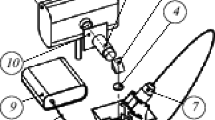Conclusions
-
1.
The probability of recombination radiation enables us to determine the correlation between the principal phosphorescence parameter γ and the degree of excitation z, so that the problem is reduced to finding either of these. This makes the correlation method convenient for experimental work.
-
2.
The correlation method enables investigation of the temperature dependence of the parameters,
-
3.
The principal parameter is determined without relevence to the thermal characteristics ɛ and p0, which in turn enables us to determine the latter; this removes the limitations imposed on the principal parameter. The correlation method can thus be used to determine the thermal characteristics in the kinetics of electronic processes.
-
4.
The very important parameters η, no, and ν remain undetermined. They cannot be evaluated, since the differential and integral forms are linear and homogeneous in (1 − γ), γυη, and p (this is why γ is determined by the correlation method). The physical reason for this is nonradiative transition
.
Similar content being viewed by others
References
E. I. Adirovich, Some Problems in the Theory of Luminescence by Crystals [in Russian], GITTL, 1951.
Author information
Authors and Affiliations
Rights and permissions
About this article
Cite this article
Arutyunyan, R.K. Determining the parameters of crystal phosphors. Soviet Physics Journal 8, 31–35 (1965). https://doi.org/10.1007/BF00823733
Issue Date:
DOI: https://doi.org/10.1007/BF00823733




